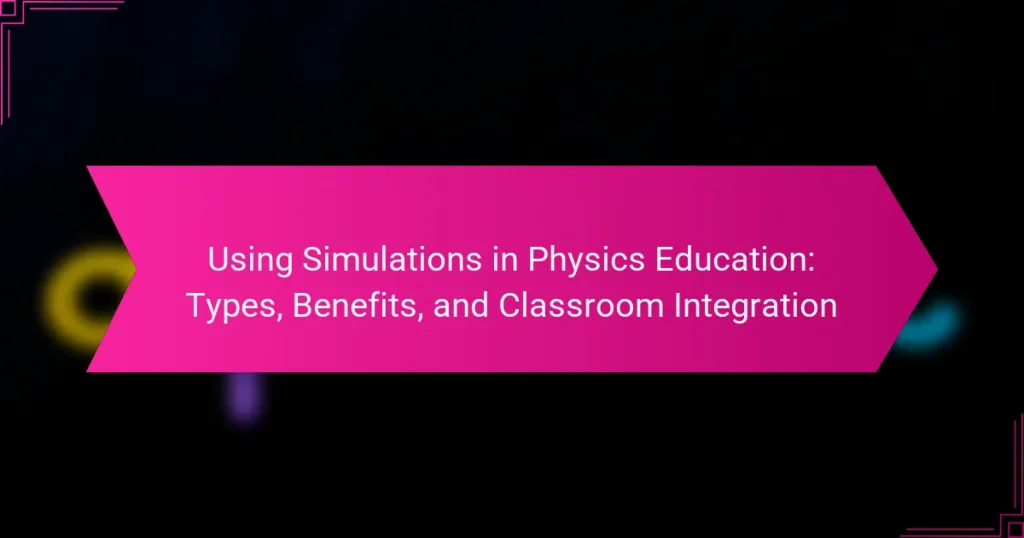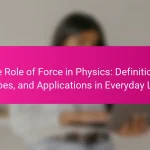Simulations in physics education are interactive models designed to replicate physical phenomena, enabling students to visualize and manipulate complex concepts. These tools enhance understanding through hands-on experiences and are effective in illustrating principles such as motion, energy, and waves. Research indicates that simulations improve student engagement and retention, with studies showing higher assessment scores among students who utilize them. The article explores various types of simulations, including virtual labs, concept simulations, game-based simulations, and modeling simulations, highlighting their benefits and effective integration strategies for teachers in the classroom. By aligning simulations with learning objectives and facilitating active learning, educators can significantly enhance students’ comprehension of complex physics topics.
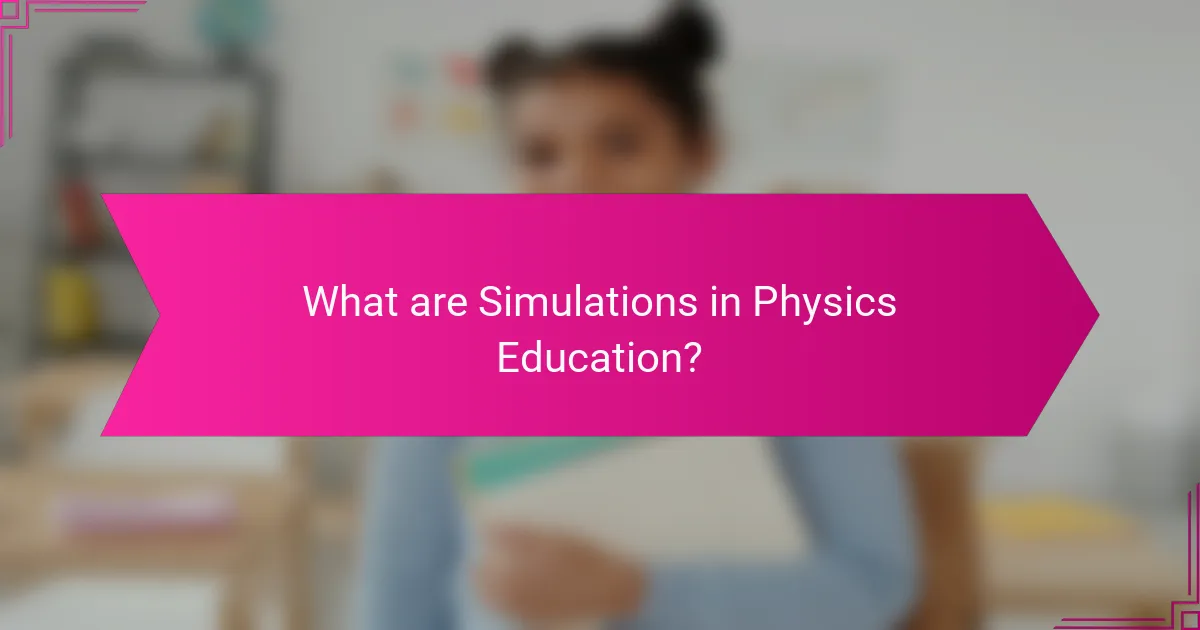
What are Simulations in Physics Education?
Simulations in physics education are interactive models that replicate physical phenomena. They allow students to visualize and manipulate complex concepts. These tools enhance understanding by providing a hands-on experience. Simulations can illustrate principles like motion, energy, and waves. Research shows they improve student engagement and retention of information. For example, a study by the University of Maryland found that students using simulations scored higher on assessments. This evidence supports the effectiveness of simulations in fostering deeper learning in physics.
How do simulations enhance the learning experience in physics?
Simulations enhance the learning experience in physics by providing interactive and visual representations of complex concepts. They allow students to experiment with variables in a controlled environment. This hands-on approach fosters deeper understanding and retention of material. Research shows that students who engage with simulations demonstrate improved problem-solving skills. A study by the University of Massachusetts found that students using simulations scored 20% higher on assessments compared to traditional methods. Simulations also cater to different learning styles, making physics more accessible. They encourage active participation, which is crucial for engagement. Overall, simulations transform abstract theories into tangible experiences.
What types of simulations are commonly used in physics education?
Common types of simulations used in physics education include computational simulations, interactive simulations, and laboratory simulations. Computational simulations model physical systems using mathematical algorithms to analyze complex interactions. Interactive simulations allow students to manipulate variables and observe outcomes in real-time, enhancing engagement. Laboratory simulations replicate experimental setups digitally, providing a safe environment for experimentation. These simulations facilitate understanding of abstract concepts and improve problem-solving skills. Research shows that students who engage with simulations demonstrate higher retention of knowledge and improved conceptual understanding.
How do simulations compare to traditional teaching methods?
Simulations provide an interactive learning experience, while traditional teaching methods often rely on lectures. Simulations engage students by allowing them to experiment in a virtual environment. This hands-on approach can enhance understanding of complex concepts in physics. Traditional methods may not offer the same level of engagement or practical application. Research indicates that students using simulations perform better in assessments compared to those taught through lectures alone. A study published in the Journal of Educational Psychology found that simulation-based learning improved conceptual understanding by 30% over traditional methods.
What are the key benefits of using simulations in physics education?
Simulations in physics education enhance understanding and engagement. They allow students to visualize complex concepts. This visualization aids in grasping abstract theories. Simulations provide a safe environment for experimentation. Students can explore scenarios without real-world consequences. Research shows that interactive simulations improve retention rates. A study by the University of Colorado found that students using simulations scored 20% higher on assessments. Simulations also promote active learning, encouraging students to participate. They can be tailored to individual learning paces. This personalization further supports diverse learning styles.
How do simulations improve student engagement and motivation?
Simulations improve student engagement and motivation by providing immersive, interactive learning experiences. They allow students to experiment in a safe environment. This hands-on approach enhances understanding of complex concepts. Research shows that students using simulations score higher on assessments. For example, a study by T. De Jong et al. in “Educational Psychologist” found that simulations increase interest and retention. Engaging with simulations encourages active participation and critical thinking. This leads to greater motivation to learn. Overall, simulations create a dynamic educational experience that fosters enthusiasm for the subject.
What cognitive skills do simulations help develop in students?
Simulations help develop critical cognitive skills in students, including problem-solving, analytical thinking, and decision-making. These skills are essential for understanding complex concepts in physics. Simulations provide interactive environments where students can experiment and observe outcomes. This hands-on experience enhances their ability to analyze situations and draw conclusions. According to a study by M. M. de Jong and H. van Joolingen, simulations improve students’ understanding of scientific concepts and foster critical thinking. The immersive nature of simulations encourages active engagement, which is crucial for cognitive skill development.
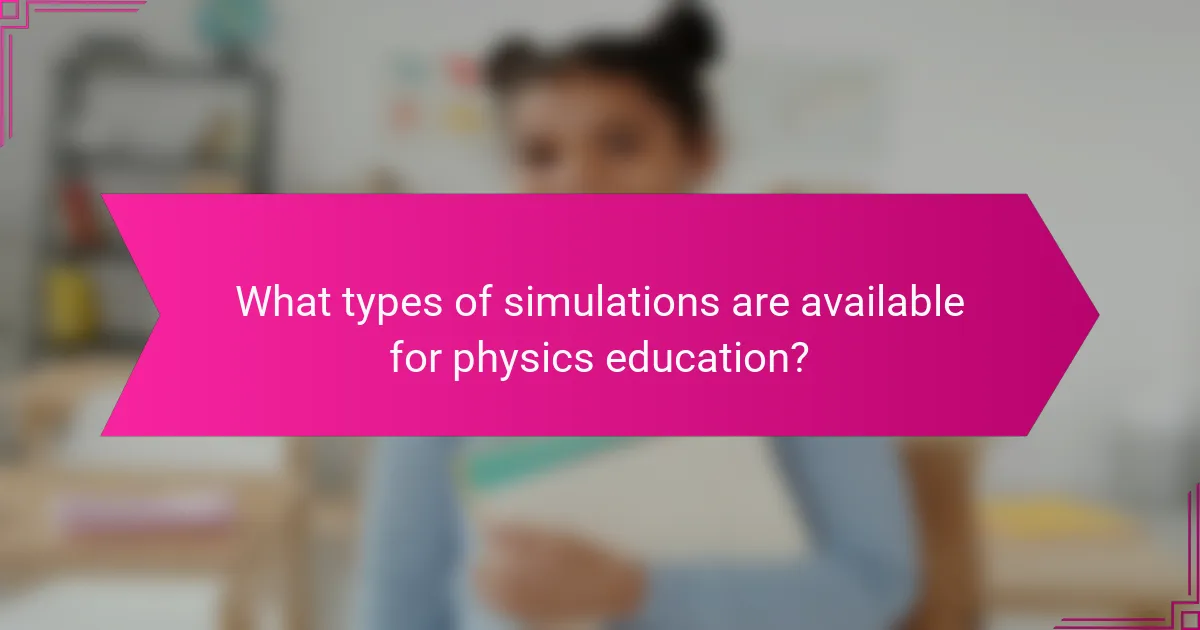
What types of simulations are available for physics education?
Interactive simulations are widely used in physics education. These simulations can include virtual labs, where students conduct experiments in a digital environment. Another type is concept simulations, which focus on illustrating specific physics concepts, such as motion or energy. Game-based simulations engage students through challenges and problem-solving scenarios. Additionally, modeling simulations allow students to visualize complex systems and phenomena. Each type enhances understanding by providing experiential learning opportunities. Research shows that simulations improve student engagement and comprehension in physics.
How do virtual labs function in physics education?
Virtual labs function in physics education by providing interactive simulations that replicate real-world experiments. These labs allow students to conduct experiments in a safe, controlled environment. Students can manipulate variables and observe outcomes without the limitations of physical resources. Virtual labs enhance understanding by visualizing complex concepts, such as motion and forces. They also provide immediate feedback, helping students learn from their mistakes. Research shows that virtual labs can improve student engagement and retention of knowledge. A study published in the Journal of Science Education and Technology found that students using virtual labs scored higher on assessments compared to those using traditional methods.
What specific experiments can be conducted using virtual labs?
Specific experiments that can be conducted using virtual labs include simulations of projectile motion, electric circuits, and wave interference. Virtual labs allow students to manipulate variables and observe outcomes in real-time. For example, in projectile motion experiments, students can adjust angles and initial velocities to see the effects on trajectory. In electric circuit simulations, learners can build circuits with different components to analyze current flow and resistance. Wave interference experiments enable users to visualize constructive and destructive interference patterns. These experiments enhance understanding through interactive learning experiences.
How do virtual labs simulate real-world physics scenarios?
Virtual labs simulate real-world physics scenarios by using computer-based models to replicate physical phenomena. They allow students to manipulate variables in a controlled environment. This interaction helps in understanding complex concepts like motion, forces, and energy. Virtual labs incorporate real-time data and feedback, enhancing the learning experience. They often use graphical representations to visualize outcomes. Research indicates that students retain knowledge better when engaging with simulations. A study by the University of California found that students using virtual labs scored 20% higher on physics assessments. This evidence supports the effectiveness of virtual labs in education.
What role do interactive simulations play in physics learning?
Interactive simulations play a crucial role in physics learning by providing hands-on experiences. They allow students to visualize complex concepts and phenomena that are often abstract. Through simulations, learners can manipulate variables and observe outcomes in real-time. This interactivity enhances engagement and motivation among students. Research shows that students using simulations demonstrate improved understanding of physics concepts. For instance, a study by the University of Colorado found that students using interactive simulations scored significantly higher on conceptual assessments. This evidence supports the effectiveness of simulations in reinforcing theoretical knowledge through practical application.
How do interactive simulations foster collaborative learning?
Interactive simulations foster collaborative learning by providing a shared platform for students to engage in problem-solving. These simulations encourage communication as students discuss strategies and outcomes. They promote teamwork by allowing learners to work together on tasks within the simulation. Research shows that collaborative environments enhance critical thinking skills. A study by Johnson and Johnson (2014) indicates that students in collaborative settings perform better academically. Interactive simulations also enable real-time feedback, facilitating group discussions based on immediate results. This dynamic interaction cultivates a deeper understanding of concepts. Overall, interactive simulations create an engaging space for collaborative learning in educational settings.
What are some popular interactive simulation platforms for physics?
PhET Interactive Simulations is a popular platform for physics simulations. Developed by the University of Colorado Boulder, it offers a wide range of interactive simulations covering various physics concepts. Another notable platform is Algodoo, which allows users to create and manipulate 2D simulations easily. Additionally, PhyWiz provides interactive physics problem-solving tools and simulations. These platforms are widely used in educational settings to enhance understanding of physics through interactive learning experiences.
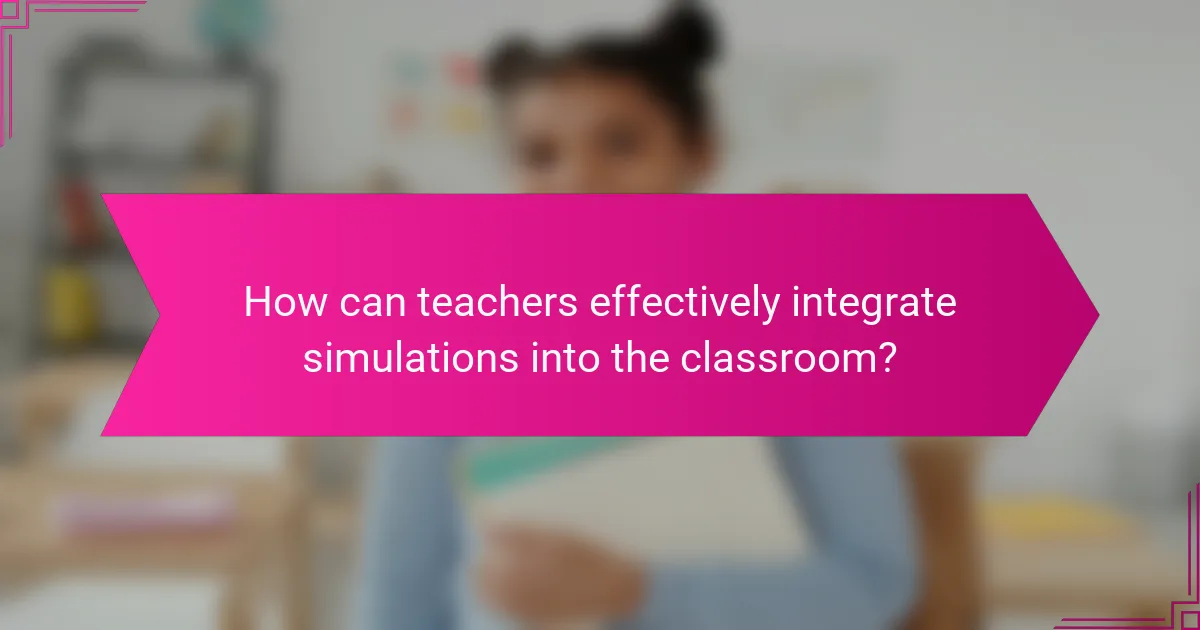
How can teachers effectively integrate simulations into the classroom?
Teachers can effectively integrate simulations into the classroom by selecting appropriate software and aligning it with learning objectives. They should ensure that the simulations are relevant to the curriculum and engaging for students. Teachers can facilitate hands-on experiences by allowing students to manipulate variables within the simulations. This promotes active learning and critical thinking skills. Additionally, incorporating discussions before and after simulation activities helps reinforce concepts. Research indicates that simulations improve understanding of complex physics concepts (Harlow et al., 2020, Journal of Physics Education Research). By providing structured guidance and feedback, teachers can enhance the learning experience further.
What strategies can educators use to implement simulations in their lessons?
Educators can implement simulations in their lessons by integrating technology effectively. They should select appropriate simulation software that aligns with learning objectives. Incorporating real-world scenarios enhances engagement and relevance. Educators can facilitate group discussions to encourage collaborative learning. Providing guided instructions helps students navigate simulations confidently. Assessing student understanding through follow-up questions reinforces learning outcomes. Utilizing feedback mechanisms within simulations supports continuous improvement. Finally, educators should reflect on the effectiveness of simulations to refine future lessons.
How can teachers assess student understanding through simulations?
Teachers can assess student understanding through simulations by observing student interactions and decision-making processes. Simulations allow students to apply theoretical concepts in practical scenarios. Teachers can analyze the choices students make during simulations to gauge their comprehension. Feedback from simulations provides insights into student misconceptions. Additionally, teachers can use pre- and post-simulation assessments to measure learning gains. Research shows that simulations enhance engagement and retention of knowledge. A study by Harlow et al. (2019) found that students demonstrated improved problem-solving skills after participating in simulations. This evidence supports the effectiveness of simulations in assessing and enhancing student understanding.
What challenges might teachers face when integrating simulations?
Teachers may face several challenges when integrating simulations into their classrooms. One major challenge is the lack of technical resources. Many schools may not have the necessary hardware or software to support simulation-based learning. Another challenge is insufficient training for teachers. Without proper training, educators may struggle to effectively implement simulations in their teaching. Additionally, there can be resistance from students. Some students may prefer traditional teaching methods and may not engage with simulations. Time constraints also pose a significant challenge. Teachers often have limited time to incorporate new methods into their curriculum. Lastly, aligning simulations with curriculum standards can be complicated. Educators must ensure that simulations meet educational goals and learning outcomes.
What best practices should educators follow when using simulations?
Educators should ensure clear learning objectives when using simulations. This helps focus the simulation on specific concepts. They should also provide adequate preparation for students. Familiarity with the simulation tools enhances engagement and understanding. Facilitating guided discussions after simulations is crucial. This reinforces learning and allows students to reflect on their experiences. Additionally, educators should encourage collaboration among students during simulations. Working in groups promotes peer learning and problem-solving skills. Lastly, continuous assessment of student understanding is essential. This can be done through quizzes or discussions to gauge comprehension of the material.
How can teachers ensure that simulations align with learning objectives?
Teachers can ensure that simulations align with learning objectives by clearly defining those objectives beforehand. They should analyze the learning goals and match them with the features of the simulation. This involves selecting simulations that specifically target the desired outcomes. Teachers must also assess the simulations for content accuracy and relevance. Incorporating feedback from students can help refine the alignment process. Regularly reviewing the effectiveness of simulations in achieving learning objectives is crucial. Research shows that simulations designed with clear educational goals improve student understanding. For example, studies indicate that simulations enhance conceptual learning in physics when aligned with specific curriculum standards.
What resources are available to support teachers in using simulations?
Teachers can access various resources to support the use of simulations in education. Online platforms like PhET provide interactive simulations specifically for physics. The National Science Digital Library offers a collection of educational resources, including simulations. Additionally, the American Association of Physics Teachers provides guidelines and materials for implementing simulations in the classroom. Research articles, such as those published in the Journal of Physics Education, often discuss effective strategies for using simulations. These resources enhance teachers’ ability to integrate simulations into their curriculum effectively.
What tips can enhance the effectiveness of simulations in physics education?
To enhance the effectiveness of simulations in physics education, educators should integrate active learning strategies. Active learning engages students more deeply with the material. Utilizing simulations that allow for manipulation of variables can foster critical thinking. Encouraging collaboration among students during simulations promotes discussion and exploration of concepts. Providing real-world context for simulations helps students relate to the material. Incorporating assessment tools within simulations can gauge understanding effectively. Regular feedback during simulation activities supports student learning. Research shows that these strategies lead to improved student outcomes in physics education.
The main entity of the article is simulations in physics education, which are interactive models that replicate physical phenomena to enhance student learning. The article outlines the various types of simulations, including computational, interactive, and laboratory simulations, and highlights their benefits, such as improved engagement, retention, and problem-solving skills. It also discusses how simulations compare to traditional teaching methods and offers strategies for effective classroom integration, including alignment with learning objectives and the use of collaborative learning techniques. Additionally, the article addresses potential challenges teachers may face and provides best practices and resources to support the implementation of simulations in physics education.
